
Sign in
Don't have an account with us? Sign up using the form below and get some free bonuses!

I recently spoke with the founder of The Invisible Woman Foundation, Anjali Pamurthy. Here's a summary of the incredibly important work she's doing for Black women, who are significantly more likely to die in childbirth than their counterparts of other races. Thank you, Anjali, for making a difference.
"...We believe that if women go into their doctor’s appointments aware of the risk, they will be able to advocate for themselves. Through education and empowerment, we will make sure that these invisible women are seen."
Anjali Pamurthy is a sophomore at the School for the Talented and Gifted at the Townview Magnet Center. She started her non profit: The Invisible Woman Foundation before her sophomore year of high school as a way to combat the racial injustices she saw in the healthcare system. She is currently working to spread awareness and education on this issue.
When I asked her for her "why," here's what she had to say:
In 2020, we all witnessed a revolution as throngs of people took to the streets to protest the death of George Floyd. That summer, a larger conversation took place about the systematic treatment of black people in the United States. As the child of a doctor, the conversations that I witnessed were about how the medical system, specifically, continued to fail black people both in the Covid-19 pandemic and beyond. The next summer, a family friend told us about a Texas House Bill that he was advocating for. This bill would create a taskforce to investigate maternal mortality in Black women. As I researched the topic, I was horrified. In the United States, death by pregnancy-related causes is three to four times more likely in black women then it is in white women. While the exact reasons for this are debated by doctors around the world, it all comes down to one thing: black women are not taken seriously by medical professionals. A demographic that has been ignored and oppressed for centuries is still being let down by the medical community. Black women are not seen or cared for by their doctors, the very people responsible for taking care of them. The Invisible Woman Foundation, a nonprofit organization that I started in my sophomore year of high school, believes that prevention will come through awareness. We believe that if women go into their doctor’s appointments aware of the risk, they will be able to advocate for themselves. Through education and empowerment, we will make sure that these invisible women are seen.
Halloween may be over, but chocolate lives on forever. That is, unless it's in my house, in which case it has a very short lifespan.
Let's face it, though. Candy is fun. Much of the Halloween hype centers around it, although in reality, most of the fun is about the novelty of the holiday. Kids often get to stay up late. Their "sometimes foods" show up by the bucket full. Houses are decorated. Energy is high everywhere they go.
But then there's the aftermath.
Here are a few ideas that you might not have thought of.
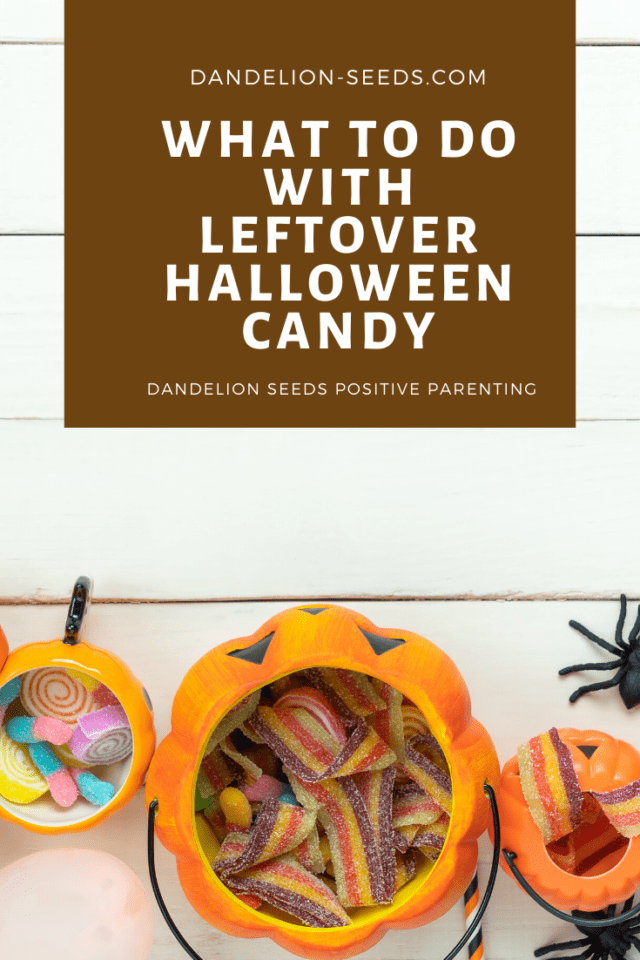
If your child doesn't have regular access to sweet treats, opening the candy floodgates and saying "Have at it!" might intimidate you. However, one absolutely solid option is to trust your child with the candy. Even the littlest of kids know when their tummies need to be in the "off" position.

Yes, some will gorge on it, particularly if sweets are a forbidden fruit, so to speak (if only they were fruit!). But there's a really smart approach to handling food that works beautifully for many families. The Ellyn Satter Division of Responsibility talks about how the parent provides the "what, where, and when" of food to which the child has access. The child, in turn, decides whether to eat it and if so, how much. Particularly when practiced consistently, it's a great way for kids to learn to trust their bodies.
Many charities accept leftover Halloween candy. Here are six that The Today Show suggested just this week and that are current as of the writing of this article.
For some reason that was unbeknownst to me, my child used to think donating leftover Halloween candy was THE thing to do. She insisted that we take it to church and give it away there. So, that's what we did for a few years. No one ever complained, especially those whose kids had long outgrown trick or treating.
This one can be a lot of fun! We didn't do this intentionally, but it's a creative idea that my child brainstormed when we were unsure what to do with candy that was problematic for her food allergies. Sneak preview: imagine which candies dissolve and which seem to keep their original forms until the end of eternity. Trust me when I say that there are certain candies (even some of my favorites, sadly) that I will never eat again after seeing what happened to them.

Some families like the Switch Witch, otherwise known as the Candy Fairy or the Great Pumpkin. Here, the child trades candy for a special toy. That's certainly a viable option!
An alternative to that is to offer your child some special time together. Many kids sincerely crave some dedicated Mommy or Daddy time more than they need more "stuff" (especially with the potential for amazing Christmas toys practically around the corner).
Parents like this option of time together because, well, it's quality time together (who can replace that?), it's sustainable and supports green living, and it gives everyone something fun to anticipate together. A single happy memory to look back on together is worth its weight in gold.
Plan something fun like a special trip to a museum, a camp-out in the living room, a walk to your child's favorite outdoor space, or a night of staying up late together watching movies on the couch. Follow through. Make it a tradition. Of course, we should be doing things like this with our kids anyway, but if we're not, this can be a good reminder.
And if you'd like to tie it all together with the holiday, save a few special pieces of leftover Halloween candy to enjoy together at your event.
According to USA Today, more than 3000 dentists across the United States are paying $1 per pound of candy. Is one near you on the list? I don't know about you, but I'd happily trade a pound of faux peanuts for some cold hard cash. So would my child.
It's all temporary. It's their booty so it's best if they get to decide what to do with it. And you might just find that the sweetest treat is a fun new tradition with your child.
I haven't met Dr. Vanessa Lapointe in person (yet), but I can say without hesitation that I'd trust her to watch my child. If you know anything about me, you'll know that I pretty much don't let anyone watch my child. And she's technically a stranger...so this isn't a lighthearted endorsement. Her first book that I read, Discipline without Damage, had me at "hello"---it simply resonated with me on every level. (afflinks) Now that she's added Parenting Right from the Start to our parenting tool kits, we all need to put it on our must-read list for parenting books.
It's a game changer for parents who want to do better for their children. Aside from covering a lot of  "basics" (among others, sleep, eating, toilet training, and positive discipline), here's what I like about it:
"basics" (among others, sleep, eating, toilet training, and positive discipline), here's what I like about it:
If the book weren't helpful enough already, Dr. Lapointe includes a section about "dandelion children" vs. "orchid children." Anyone with a highly sensitive child might know these terms; they refer to two distinctly different temperaments and their abilities to thrive in different circumstances. This knowledge is near and dear to my heart as a parent raising an orchid (a highly sensitive child). Regardless whether this analogy speaks to you, Dr. Lapointe's expertise about individual differences among children---and the most effective ways to parent them---is unquestionably beneficial.
She helps us examine our own "wiring" as parents. She helps us understand the beliefs with which we enter into parenthood and might not even realize we have. It's beyond beneficial; it's a therapeutic mindset from which we all can benefit.
One of my own struggles when I was a new mom was feeling isolated in my parenting style. Most of the other moms I knew were raising their kids in a way that just didn't work for my heart. I longed for other like-minded adults to connect with in my parenting journey, often wondering if I was just way off base. Fortunately, I did find my proverbial tribe (and some other great parenting books along the way), but how much nicer it would've been to have Dr. Lapointe's professional expertise in my back pocket from the start! I'd have felt more sure of the approach that I follow with my whole heart and with full confidence, now.
If I were to sum up the book in a sentence, I'd say it's a book about how to foster a lifelong and positive connection with your child. When it comes right down to it, that's what's most important. And that's exactly what this book helps us do in big and little ways.
From a place of connection, our kids feel safe to be who they are; to embrace the goodness that we've imparted to them; and to carry it out into the world beyond our homes. After all, that's a wonderful measure of success as parents, isn't it?
When my daughter was three years old, I didn't think anything about fostering childhood resilience when it came to Halloween. For some reason that's unbeknownst to me, she decided that what people do with Halloween candy is...donate it. Who was I to argue with her thoughtful idea? So, for the past two years, we've gathered up her loot and handed it off to a grateful recipient.
I somehow assumed that this is what she'd want to do with it forever. Yeah, just call me naive and we'll get on with things, shall we? In any case, we started Halloween today with our standard plan to donate her candy. She was completely on board.
So, off we went to our downtown "Safe Halloween" where local businesses open their doors to the kids and their parents for a couple of hours, doling out all the good stuff. Now, what makes the "good stuff" tricky for us is that my kiddo has food allergies, so donating her candy has always eliminated any risk to her safety. The Teal Pumpkin Project helps somewhat, but not everyone knows about it or chooses to participate.
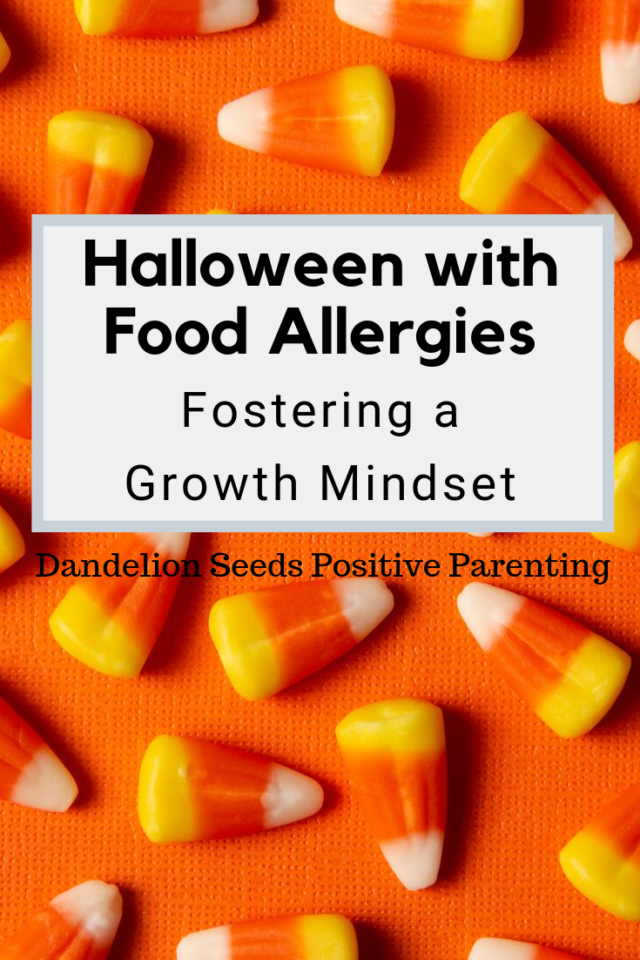
When we were done trick-or-treating, however, she crawled into the backseat of my car, opened her big paper bag, and took a quick whiff of the contents of the sugar-filled booty. I glanced back at her after another minute, and although her hands were still on the outside, her head had disappeared almost entirely into the bag. It smelled good. That's when I started to realize that this year might be
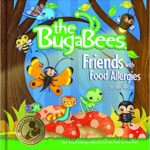
different. She might not want to donate the good smells.
When we got home, she inquired while holding up one of her goodies, "Mommy, can you please read the ingredients to this one?" Suddenly, I realized we were on a very slippery slope. What had been an easy fix to a problem wasn't going to work this year. Since reading The Bugabees (which I love for kids with food allergies), she's learned to ask what's in the food to which she's exposed. (Afflink) That's wonderful.
For better or worse, however, most commercial candies simply aren't options for her health-wise. To compensate for that, we have alternate "safe" treats at our house, usually healthy options. She'd broken off a square of dark chocolate during lunch at home just a few hours earlier as a special treat.
With all that in mind, I read the ingredients. She quickly self-identified that the candy she chose wouldn't work for her. And then she mourned.
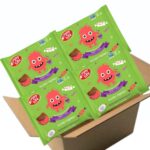
Empathizing, I told her, "I saw how much you really wanted that candy. The feelings I'm guessing you have right now are disappointment and sadness. You can tell me if I'm wrong." It helps kids to give names to feelings to help build emotional intelligence. Dr. John Gottman writes about this, along with a lot of other really insightful suggestions, in this book. It's best when children can name the emotions themselves, but that doesn't always work when they're emotionally flooded. She agreed that I'd guessed correctly.
After holding her and telling her I understood (truly, I do), I realized that this would be another teachable moment. I had to wait, of course, until her brain could find logic and reason, as this important book by Drs. Seigel and Bryson so clearly illustrates. One of the lessons I've learned, though, is that she learns best
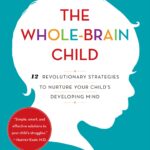
when I give her the space to solve problems for herself--while I fully support her emotionally along the way. This is a life skill she needs.
Knowing the rest of her loot would be similar, I offered, "I wonder what we could do to make the rest of the candy less tempting. Let's think about this." And then I waited, just a bit longer than where I felt comfortable. It's usually in that uncomfortable moment when she suggests something.
"I have an idea, Mommy."
"What is it?"
"Let's make it a science experiment. You grab a bowl and put some hot water in it; I'll put the candy in it and see what happens."
We proceeded to make a warm, gooey, good-smelling experiment while sitting in the middle of our kitchen floor. I hadn't thought of the idea. She had. And when she did, she bought in completely. We marveled at which ones floated or sank, and which ones bubbled (I'm never eating that kind again). She solved the problem in a way that will undoubtedly stay with her much longer than anything I'd have suggested, would have. And I believe she learned something about her own resilience.
Although I don't know if this candy-plan will work again next year, what I do know is this: she's capable of figuring it out. She's strong. I love that she has opportunities to see this.
_______________________________________________________
Click the images for details!



In positive parenting, the power of a hug is some of the best preventative medicine that exists for the adult-child relationship, even with children who aren’t our own.
A girl I'll call Juniper, who was then two and a half years old, was standing with my child and me in the doorway just before we joined Teacher Tom for outdoor story time. It was the very first time I'd ever met her. I was the last adult chaperoning kids out of the building, so I couldn't join story time with my child until I was sure all the kids were accounted for. Juniper had no intention of joining us, though, as I could clearly see from her body language. As Teacher Tom noticed my child and me waiting in the vestibule, he beckoned for us to join him. A lot of people were waiting for us. He was unaware that I was encouraging Juniper, who was cowering in a corner, to follow us.
In an attempt to connect with Juniper, I crouched down to her level and reached out my hand. I'd have held her hand, hugged her, or picked her up, if she'd indicated any of those options were acceptable. To my surprise, however, she jumped at me like a mini-superhero, then started throwing punches and kicking me. She tried to bite my arm. Holy moly.
Despite being momentarily stunned, I heard myself think, "I'm going to Janet Lansbury this." (I didn't know Janet was a verb. I always thought she was an early childhood expert.) As calmly as I could muster despite Juniper's flailing limbs, I held her shoulders at a safe distance from my body. I looked her in the eye and said, "I won't let you hurt me. I'll help you through this." Immediately, she calmed, took a final halfhearted swing at me, and took off running down the hallway of the building. Knowing I couldn't leave a child alone in there, I invited my child to follow me as I gently pursued Juniper. I gave her plenty of space.
To be clear, I use positive discipline as a synonym for teaching. I don't support force or punishment of any kind as a parenting approach. In my experience, a hug and almost any form of positive parenting go so much farther than anything punitive.
Before I continue with what happened, it’s helpful to understand some of the different approaches I could’ve taken, based on different parenting styles. This child didn’t need to be mine for the same neuroscience to apply.
If I acted like an authoritarian parent, it likely would've presented as me yelling after her, catching her, and picking her up against her will. Flailing or not, I'd plop her down into to story time. Traditional authoritarian parenting (the most commonly punitive option) centers around adults controlling children. It has negative long-term consequences for the parent and child relationship, as well as for the child
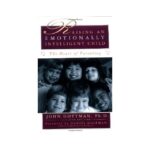
herself, as John Gottman, Ph.D. describes in Raising an Emotionally Intelligent Child (afflinks). Forced compliance does nothing to support children’s emotional intelligence or attachment to their caregivers, and I certainly wasn't going to make this little stranger "behave" somehow.
On the opposite end of the parenting style continuum from authoritarian parenting is permissive parenting. However, Dr. Gottman, Janet Lansbury, and many other experts caution that permissive parenting isn't the antidote to authoritarian parenting. It, too, carries risks for the child. Children need loving and reasonable limits to feel secure. Permissive parenting might’ve looked like my letting Juniper run wherever she wanted, and not saying a word to her about it.
Neither approach would've given Juniper helpful tools upon which to rely in the future. Moreover, if she happened to be a highly sensitive child (HSC), odds are good that anything punitive might have sent her into an even tougher emotional situation.
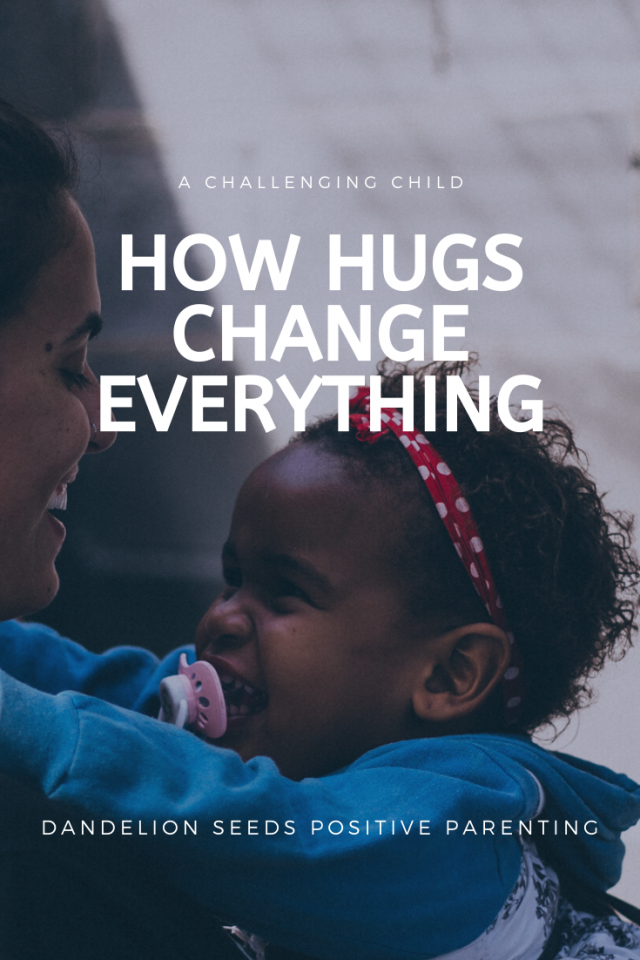
This balanced type of positive parenting is called authoritative parenting. Note that although the name authoritarian parenting, which is negative, sounds like authoritative parenting, the latter is positive.
In any case, this certainly wasn't the time for a sticker chart or a "red behavior card,” which is common in many preschools. (I'd argue that no time is right for those, but that's another post.) As Ross Greene, Ph.D., argues in The Explosive Child, "...The reason reward and punishment strategies haven't helped is because they won't teach your child skills he's lacking or solve the problems that are contributing to
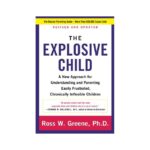
challenging episodes..." These methods don't teach children how to cope when they're emotionally overloaded.
Conversely, positive parenting is linked with better long-term outcomes for the child. This is true not only short-term, but also for the child's long-term wellbeing (1). Examples of positive parenting styles include RIE® (2), attachment parenting, authoritative parenting, and many others. Descriptions are readily available on the Internet, and my website has a list of my favorite positive parenting books. (Yep, I've read everything there. I share only the ones that have solid, actionable messages and that promote positive parenting.) I wish I had a dollar for every style of parenting in the dictionary these days, but truthfully, the names don't matter much.
All that said, I wasn't entirely enthusiastic about pursuing this small Mike Tyson. However, I realized that this responsibility was on me even if I didn't sign up for it.
I trusted that I was there for a reason. I needed to find that middle ground that would help Juniper trust that I was on her side while still accomplishing what we needed to do: reconnect with the class.
So, I offered her a hug. Totally bewildered for a moment, she yelled, "No!" And then she sucked her thumb, rocked herself, fell to the floor crying, and then got up and ran at me again. For a moment, I almost blocked my body for safety. I saw something different in her eyes, though, so I stayed within reach. She ran to me as if I were a long lost friend and collapsed into my arms, bawling her little eyes out.
She hugged and hugged and hugged, leaving my daughter and me surprised, but on we went hugging. Her tension melted away entirely. We proceeded to story time peacefully.
At that point and for reasons unbeknownst to me at the time, I told her that I have a "hug button" on my shoulder. Anytime she'd need one, she could come and touch my shoulder, and I'd know what to do. I made sure to always crouch down when she came near, just in case she needed to push it.
If any child were to put something unsafe in her mouth and start running down the hill on the playground, it was her. With some false starts, I learned that following her and asking her to remove the choking hazard would backfire. It was all the convincing she needed to keep the aforementioned item there. When I pushed too hard or sounded forceful, fearing for her safety, she’d take off running and create an even greater safety risk to herself.
Once I realized that, I chose to address her potential issues proactively. The moment I saw her put something in her mouth, I'd crouch down and call her name from wherever I was on the playground. I'd stay put. She'd look over, and I'd point to the invisible hug button on my shoulder.
More often than not, she'd nod and come running my direction (sometimes with the aforementioned object still in her mouth, but it was progress). She'd hug me for as long as she needed and then relinquish the item.
Except for when she didn't come. I'm not perfect (more like a million miles from it), and sometimes my tone would be too worrisome for her. Or sometimes I'd think I'd done it "right," but she was too emotionally overloaded to connect.
I lost count of how many times a proactive hug completely deescalated potential problems. I'd see a "look" on her face that signaled trouble, so I'd offer a hug. And just like magic, all was right with her world again. Some of the other kids in class even joined in on the “hug button” initiative.
On the last day of class, Juniper walked up to me and offered me a hug for the first time, proactively. She'd never done that before. I happily accepted. Much to my surprise, she cupped my face in her little hands and she whispered, "I love you." It was the perfect 2.5-year-old translation of "Thank you for understanding exactly what I needed when I didn't have the words to explain it."
And I love her, too, in the most wonderful way of loving a small person I'll likely never see again. She helped show me the power of positive parenting from a lens outside that of my own family. She reinforced that it's better not to chase my child; but instead, to be rock solid and a "safe place" emotionally. She confirmed what the the gentle parenting books say should happen when a child feels connected. My own parenting is better for the important positive parenting lesson she taught me.
There's a lot to be said for the power of a hug.
_____________________________________________________________
Source (1): https://www.parentingscience.com/authoritative-parenting-style.html
Source (2): https://www.rie.org/educaring/ries-basic-principles/